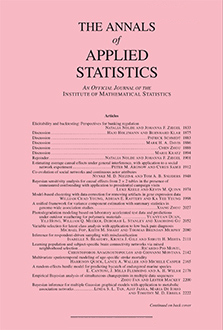Abstract
Diffusion tensor imaging (DTI) plays a key role in analyzing the physical structures of biological tissues, particularly in reconstructing fiber tracts of the human brain in vivo. On the one hand, eigenvalues of diffusion tensors (DTs) estimated from diffusion weighted imaging (DWI) data usually contain systematic bias, which subsequently biases the diffusivity measurements popularly adopted in fiber tracking algorithms. On the other hand, correctly accounting for the spatial information is important in the construction of these diffusivity measurements since the fiber tracts are typically spatially structured. This paper aims to establish test-based approaches to identify anisotropic water diffusion areas in the human brain. These areas in turn indicate the areas passed by fiber tracts. Our proposed test statistic not only takes into account the bias components in eigenvalue estimates, but also incorporates the spatial information of neighboring voxels. Under mild regularity conditions, we demonstrate that the proposed test statistic asymptotically follows a $\chi^{2}$ distribution under the null hypothesis. Simulation and real DTI data examples are provided to illustrate the efficacy of our proposed methods.
Citation
Tao Yu. Chunming Zhang. Andrew L. Alexander. Richard J. Davidson. "Local tests for identifying anisotropic diffusion areas in human brain with DTI." Ann. Appl. Stat. 7 (1) 201 - 225, March 2013. https://doi.org/10.1214/12-AOAS573
Information





